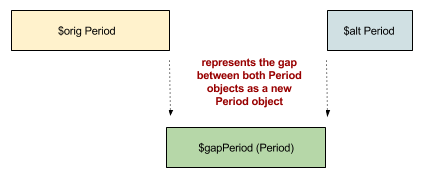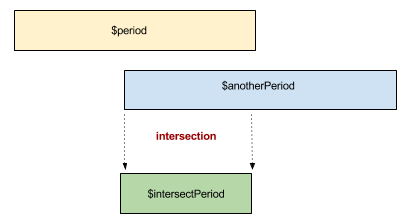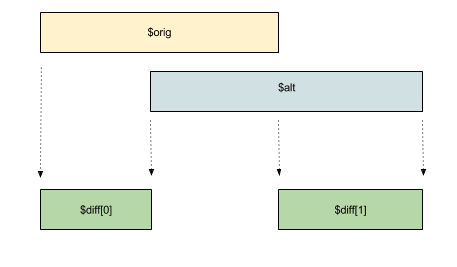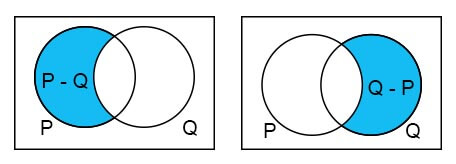Comparing
You can compare different Period objects according to their datepoints or durations.
Using durations
Sorting objects
public Period::durationCompare(Period $interval): int
public Period::durationGreaterThan(Period $interval): bool
public Period::durationLessThan(Period $interval): bool
public Period::durationEquals(Period $interval): bool
The method Period::durationCompare compares two Period objects according to their duration. The method returns:
1if the current object duration is greater than the submitted object duration;-1if the current object duration is lesser than the submitted object duration;0if the current object duration is equal to the submitted object duration;
To ease the method usage you can rely on the following proxy methods:
Period::durationGreaterThanreturnstruewhenPeriod::durationComparereturns1Period::durationLessThanreturnstruewhenPeriod::durationComparereturns-1Period::durationEqualsreturnstruewhenPeriod::durationComparereturns0
Examples
$orig = Period::after('2012-01-01', '1 MONTH');
$alt = Period::after('2012-01-01', '1 WEEK');
$other = Period::after('2013-01-01', '1 MONTH');
$orig->durationCompare($alt); //return 1
$orig->durationGreaterThan($alt); //return true
$orig->durationLessThan($alt); //return false
$alt->durationCompare($other); //return -1
$alt->durationLessThan($other); //return true
$alt->durationGreaterThan($other); //return false
$orig->durationCompare($other); //return 0
$orig->durationEquals($other); //return true
$orig->equals($other); //return false
//the duration between $orig and $other are equals but not the datepoints!!
Returning the duration differences
public Period::dateIntervalDiff(Period $interval): DateInterval
public Period::timestampIntervalDiff(Period $interval): float
Returns the duration difference between two Period objects using a DateInterval object or expressed in seconds.
Examples
use League\Period\Period;
$interval = Period::fromSemester(2012, 1);
$alt_interval = Period::fromIsoWeek(2012, 4);
$diff = $interval->dateIntervalDiff($alt_interval);
// $diff is a DateInterval object
$diff_as_seconds = $interval->timeDurationDiff($alt_interval);
//$diff_as_seconds represents the interval expressed in seconds
Using datepoints and boundary types
All following methods results take into account the interval datepoints as well as its boundary types.
Period::isBefore
public Period::isBefore(mixed $index): bool
Tells whether the current Period object datetime continuum is entirely before the specified $index.
Parameter
The $index argument can be another Period object or a datepoint.
Examples
$period = Period::fromMonth(1983, 4);
$alt = Period::fromMonth(1984, 4);
//test against another Period object
$period->isBefore($alt); //returns true;
$alt->isBefore($period); //return false;
//test againts a datepoint
$period->isBefore('1983-06-02'); //returns true
$period->isBefore('1982-06-02'); //returns false
$period->isBefore($period->getEndDate()); //returns true
Period::isDuring
public Period::isDuring(Period $interval): bool
A Period is contained into another if its datetime continuum is completely contained within the submitted Period datetime continuum.
Examples
//comparing a datetime
$period = Period::fromMonth(1983, 4);
//comparing two Period objects
$alt = Period::after('1983-04-12', '12 DAYS');
$period->contains($alt); //return true;
$alt->isDuring($period); //return true;
Period::isAfter
public Period::isAfter(mixed $index): bool
Tells whether the current Period object datetime continuum is entirely after the specified $index.
Parameter
The $index argument can be another Period object or a datepoint.
Examples
$period = Period::fromMonth(1983, 4);
$alt = Period::fromMonth(1984, 4);
//test against another Period object
$alt->isAfter($period); //returns true;
$period->isAfter($alt); //return false;
//test againts a datepoint
$period->isAfter('1983-06-02'); //returns false
$period->isAfter('1982-06-02'); //returns true
$period->isAfter($period->getStartDate()); //returns false
Period::bordersOnStart
public Period::bordersOnStart(Period $interval): bool
A Period borders on the starting datepoint of another instance if its ending datepoint is immediately before the submitted Period starting datepoint without overlapping.
Examples
//comparing a datetime
$period = Period::fromMonth(1983, 4);
//comparing two Period objects
$alt = Period::fromMonth(1983, 3);
$alt->bordersOnStart($period); //return true;
Period::bordersOnEnd
public Period::bordersOnEnd(Period $interval): bool
A Period borders on the ending datepoint of another instance if its starting datepoint is immediately after the submitted Period end datepoint without overlapping.
Examples
//comparing a datetime
$period = Period::fromMonth(1983, 4);
//comparing two Period objects
$alt = Period::fromMonth(1983, 3);
$period->bordersOnEnd($alt); //return true;
Period::abuts
public Period::abuts(Period $interval): bool
A Period abuts if it starts immediately after, or ends immediately before the submitted Period without overlapping.

Examples
$period = Period::fromMonth(2014, 3);
$alt = Period::fromMonth(2014, 4);
$period->abuts($alt); //return true
//in this case $period->getEndDate() == $alt->getStartDate();
Period::overlaps
public Period::overlaps(Period $interval): bool
A Period overlaps another if they share some common part of their respective continuous portion of time without abutting.
Examples
$orig = Period::fromMonth('2014-03-15');
$alt = Period::fromMonth('2014-04-15');
$other = Period::after('2014-03-15', '3 WEEKS');
$orig->overlaps($alt); //return false
$orig->overlaps($other); //return true
$alt->overlaps($other); //return true
Period::isStartedBy
public Period::isStartedBy(mixed $index): bool
- Tells whether both
Periodobjects starts at the same datepoint. - Tells whethter the submitted
DateTimeInterfaceobject is the interval included starting datepoint
Parameter
The $index argument can be another Period object or a datepoint.
Examples
$period = Period::fromMonth(2014, 3);
$alt = Period::after('2014-03-01', '2 DAYS');
$period->isStartedBy($alt); //return true
//in this case $period->getStartDate() == $alt->getStartDate();
// and $period->isStartIncluded === $alt->isStartIncluded;
Period::isEndedBy
public Period::isEndedBy(mixed $index): bool
- Tells whether both
Periodobjects ends at the same datepoint. - Tells whether the submitted
DateTimeInterfaceobject is the interval included ending datepoint
Parameter
The $index argument can be another Period object or a datepoint.
Examples
$period = Period::fromMonth(2014, 3);
$alt = Period::before('2014-04-01', '2 DAYS');
$period->isEndedBy($alt); //return true
//in this case $period->getEndDate() == $alt->getEndDate();
// and $period->isEndExcluded() === $alt->isEndExcluded();
Period::equals
public Period::equals(Period $interval): bool
Tells whether two Period objects shares the same datepoints and the same boundary type.
Examples
$orig = Period::fromMonth(2014, 3);
$alt = Period::fromMonth(2014, 4);
$other = Period::after('2014-03-01', '1 MONTH');
$otherInclusif = Period::after('2014-03-01', '1 MONTH', Period::INCLUDE_ALL);
$orig->equals($alt); //return false
$orig->equals($other); //return true
$orig->equals($otherInclusif); //return false because the boundary are not the same
Period::contains
public Period::contains(mixed $index): bool
- A
Periodcontains a datepoint reference if this datepoint is present in its datetime continuum. - A
Periodcontains anotherPeriodobject if the latter datetime continuum is completely contained within thePerioddatetime continuum.
Parameter
The $index argument can be another Period object or a datepoint.
Examples
//comparing a datetime
$period = Period::fromMonth(1983, 4);
$period->contains('1983-04-15'); //returns true;
$period->contains($period->getStartDate()); //returns true;
$period->contains($period->getEndDate()); //returns false;
//comparing two Period objects
$alt = Period::after('1983-04-12', '12 DAYS');
$period->contains($alt); //return true;
$alt->contains($period); //return false;
Period::gap
public function gap(Period $interval): Period
A Period has a gap with another Period if there is a non-zero interval between them. This method returns the amount of the gap as a new Period object only if they do actually have a gap between them. If they overlap a Exception is thrown.

Examples
$interval = Period::after('2012-01-01', '2 MONTHS');
$alt_interval = Period::after('2013-01-15', '3 MONTHS');
$gap = $interval->gap($alt_interval);
Period::intersect
public function intersect(Period $interval): Period
An Period overlaps another if it shares some common part of the datetime continuum. This method returns the amount of the overlap as a Period object, only if they actually do overlap. If they do not overlap, then an Period\Exception is thrown.

Examples
$interval = Period::after('2012-01-01', '2 MONTHS');
$alt_interval = Period::after('2012-01-15', '3 MONTHS');
$intersection = $interval->intersect($alt_interval);
Period::diff
public Period::diff(Period $interval): array
This method returns the difference between two Period objects only if they actually do overlap. If they do not overlap or abut, then an Exception is thrown.
The difference is expressed as an array. The returned array always contains two values:
- both values are
nullif both interval share the same datepoints; - contains one
Periodobject and anullvalue if both objects share only one datepoint; - contains two
Periodobjects if no datepoint are shared between objects. The firstPerioddatetime continuum is always entirely set before the second one;

Examples
$orig = Period::after('2013-01-01', '1 MONTH');
$alt = Period::after('2013-01-15', '7 DAYS');
list($first, $last) = $orig->diff($alt);
// $diff is an array containing 2 Period objects
$first->equals(new Period('2013-01-01', '2013-01-15')); // returns true
$last->equals(new Period('2013-01-23', '2013-02-01')); // returns true
$first->isBefore($last); //return true;
//this is always true when two Period objects are present
Period::subtract
public Period::subtract(Period $interval): Sequence
This method returns the difference between two Period objects. It differs from Period::diff as:
- the method is not commutative;
- the method returns a Sequence object;
- the method never throws even when the instances do not overlaps;

Examples
$periodA = Period::after('2000-01-01 10:00:00', '8 HOURS');
$periodB = Period::after('2000-01-01 14:00:00', '6 HOURS');
$periodC = Period::before('2019-01-03', '1 MONTH');
$sequenceAB = $periodA->subtract($periodB);
count($sequenceAB); //returns 1
$sequenceAB[0]->equals
new Period($periodA->getStartDate(), $periodB->getStartDate())
);
$sequenceBA = $periodB->subtract($periodA);
count($sequenceBA); //returns 1
$sequenceBA[0]->equals(
new Period($periodA->getEndDate(), $periodB->getEndDate())
);
$sequenceAC = $periodA->subtract($periodC);
count($sequenceAC); //returns 1
$sequenceAC[0]->equals($periodA); //returns true
$sequenceCA = $periodC->subtract($periodA);
count($sequenceCA); //returns 1
$sequenceCA[0]->equals($periodC); //returns true
